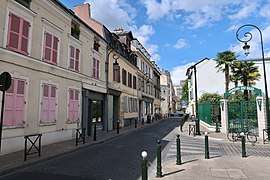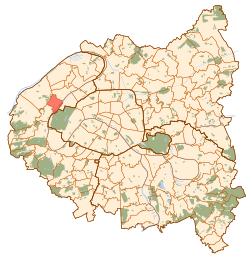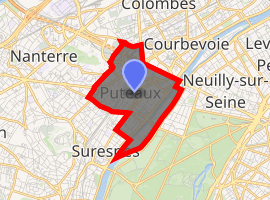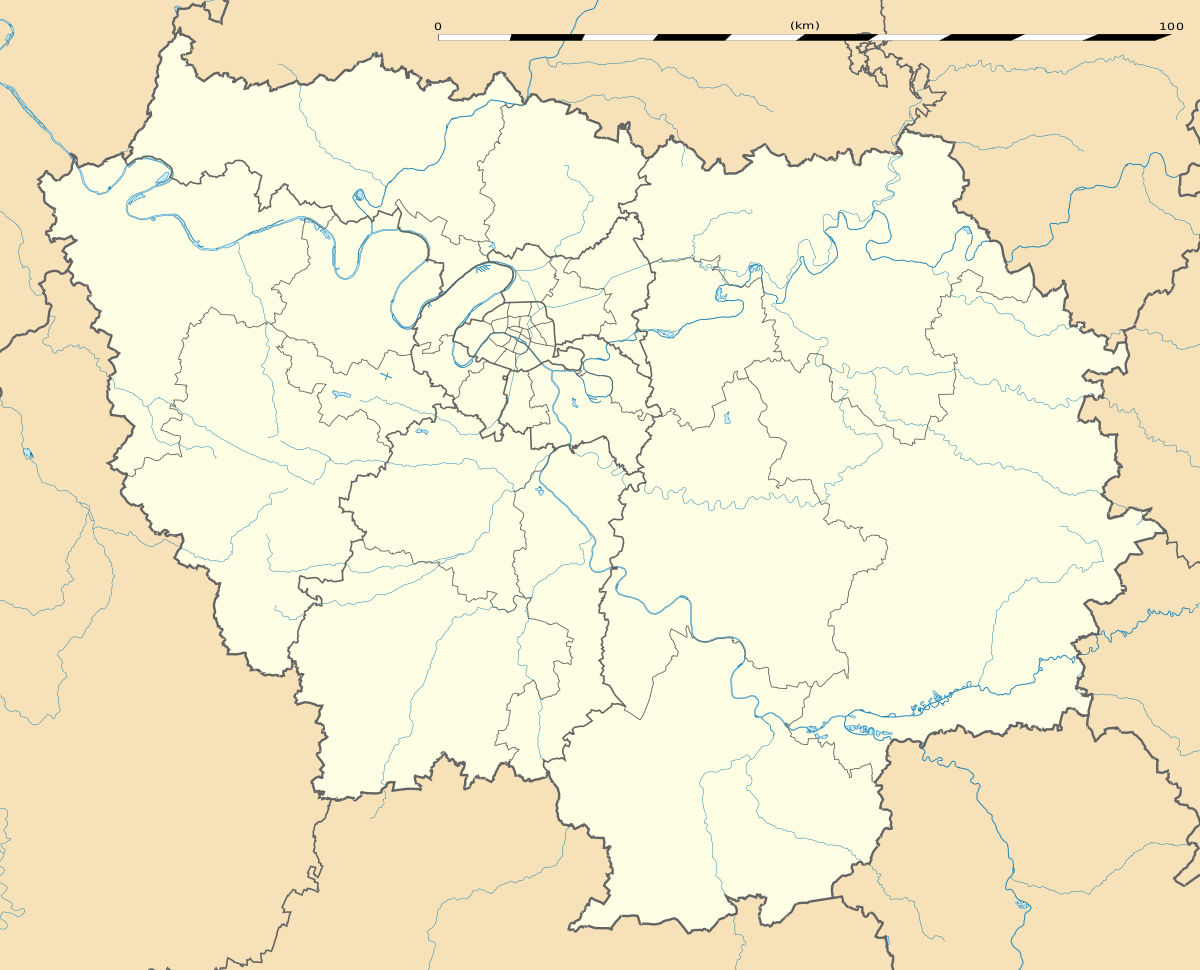Puteaux
Puteaux (French pronunciation: [pyto]) is a commune in the western suburbs of Paris, France. It is located in the heart of the Hauts-de-Seine department, 8.7 kilometres (5.4 mi) from the centre of Paris. In 2016, it had a population of 44,941.
Puteaux | |
|---|---|
 Rue Voltaire | |
.svg.png) Coat of arms | |
 Paris and inner ring départements | |
Location of Puteaux 
| |
 Puteaux Paris and inner ring départements  Puteaux Puteaux (Île-de-France (region)) | |
| Coordinates: 48°53′06″N 2°14′20″E | |
| Country | France |
| Region | Île-de-France |
| Department | Hauts-de-Seine |
| Arrondissement | Nanterre |
| Canton | Courbevoie-2 |
| Intercommunality | Grand Paris |
| Government | |
| • Mayor (2015–2020) | Joëlle Ceccaldi-Raynaud |
| Area 1 | 3.19 km2 (1.23 sq mi) |
| Population (2017-01-01)[1] | 44,645 |
| • Density | 14,000/km2 (36,000/sq mi) |
| Time zone | UTC+01:00 (CET) |
| • Summer (DST) | UTC+02:00 (CEST) |
| INSEE/Postal code | 92062 /92800 |
| Elevation | 29–78 m (95–256 ft) |
| 1 French Land Register data, which excludes lakes, ponds, glaciers > 1 km2 (0.386 sq mi or 247 acres) and river estuaries. | |
La Défense, Paris's business district hosting the tallest buildings in the metropolitan area, spreads over the northern part of Puteaux and parts of the neighbouring communes Courbevoie and Nanterre. The inhabitants of Puteaux are called Putéoliens in French.
History
The creation of the city dates from 1148, by Abbot Suger and gave him the name Putiauz. The foundation of Puteaux part of several other towns in the region by Abbot Suger, as Carrières-sur-Seine, Vaucresson or Villeneuve-la-Garenne and aimed to attract people in the region. This appeal was reinforced by certain privileges granted by the Abbot Suger.
The name Putiauz comes from the old French Putel, which means a "quagmire" or "swamp" and was certainly making reference to the condition of the area before its reorganization.
But another etymology exists, hence the name Puteaux would come from Latin puteoli, plural of puteolus which means "little well" or "Water hole". The name of Puteaux in turn appears to the sixteenth century or seventeenth century.
Legend has it that Puteaux inspired the story of the gadfly from La Fontaine.
Geography
Located on the left bank of the river Seine, Puteaux borders Courbevoie to the north, Nanterre to the west and Suresnes to the south. In the east, Puteaux is connected to Paris by the bridge of Puteaux near Neuilly and by the bridge of Neuilly (which is also used by Paris Métro Line 1). The territory of the commune of Puteaux also includes the largest part of the Île de Puteaux, on the Seine.
Districts
Within Puteaux several districts can be distinguished.
The district Bas de Puteaux, located between the railway line and the Seine, is the oldest urbanized district. Notable in particular are the old church, the Théâtre des Hauts-de-Seine, the town hall and a commercial shopping mall near the rues Jaurès, Eichenberger and Chantecoq. The town hall was built in 1934 and is a typical example of the architecture of this time. The boulevard Richard Wallace is the Champs-Élysées of Puteaux.
The district Haut de Puteaux, located to the east of the railway line, is a more recent district, made of several residences and HLM (résidences des rosiers, Cartault, Marcellin Berthelot, Bernard Palissy) The Lorilleux residence, for example, was built on the site of the old ink manufacturing companies.
The district La Défense is located in the north, separated by the circular boulevard. The district, developed since the end of the 1950s, is one of the principal business districts in Europe. It mainly consists of office buildings, but some notable dwellings can be found within the district as well (Tour Défense 2000, résidence Boieldieu). Two thirds of the territory of La Défense is located within Puteaux, the remainder being divided between Courbevoie and Nanterre. Thus, the CNIT, the Arche de la Défense and the Quatre Temps shopping mall are in Puteaux.
The district Île de Puteaux, on which there are no dwellings besides some barges, shelters the sporting structures (tennis courts, football pitch, gymnasium, swimming pool) of Puteaux. A sporting complex, the Palais des sports, opened in July 2006.
Government and infrastructure
Tour Pascal B in La Défense and in Puteaux has the head offices of the Bureau d'Enquêtes sur les Événements de Mer and of the Ministry of Ecology, Energy, Sustainable Development and Sea.[2][3]
Economy
The tax revenue of La Défense makes Puteaux one of the richest communes of France. Puteaux receives forty million euros per year coming from the companies within the district alone. Puteaux does not have a debt and its financial reserves, placed in Treasury bills, returns ten million euros in interest alone. The budget of Puteaux can thus exceed 200 million euros (reference 2005), for only 42,000 inhabitants.
Puteaux has a long industrial past, in particular the car industry (De Dion-Bouton, but also Unic, Saurer and Daimler-Benz), aeronautics: (Zodiac Group), the armament industry: Atelier de Construction de Puteaux (APX), inks (Charles Lorilleux) and perfumes (Coty).
Politics
Charles Ceccaldi-Raynaud (Union for a Popular Movement, UMP) was the mayor of Puteaux from 1969 to 2004. In 2004 he was succeeded by his daughter Joëlle Ceccaldi-Raynaud (UMP). She was also temporarily appointed as a Member of Parliament for the 6th district of Hauts-de-Seine (Puteaux/Neuilly-sur-Seine) instead of Nicolas Sarkozy.
The administration of Puteaux by Ceccaldi-Raynaud is considered authoritarian by certain people (the opposition but sometimes also certain people of their own political camp in Hauts-de-Seine). This criticism regularly has echoes in the media (like the daily newspapers Libération, Le Monde, the edition of Hauts-de-Seine of Le Parisien and the news magazine L'Express, which made a coverstory of it at the end of 2005).
In September 2005, Charles Ceccaldi-Raynaud announced his intention to become mayor again, instead of his daughter. However, his daughter refused to resign. A lot of fixing was needed, in particular in the Municipal council (reported in a dispatch of the AFP of November 21, 2005).
Municipal administration
The mayors of Puteaux:
- Guillaume Nezot (in 1790).
- Pierre Nezot (in 1791).
- Philippe Gault (1791–1795).
- Guillaume Nezot (1795–1800).
- Jean Saulnier (1800–1816).
- Denis Legrand (1816–1826).
- Bernard Gerhard (1826–1831).
- Pierre Langlasse (refused the function).
- Victor Beau (in 1832).
- Guillaume Julien (1833–1840).
- Claude Pitois (1840–1847).
- Gabriel Panay (in 1848).
- Alfred Michel (1848–1851).
- Jean-Baptiste Léonard (1851–1857).
- Léon Godefroy (1857–1858) (deceased in function).
- Joseph Boucherot (1858–1870).
- Simon-Hyacinte Blanche (in 1870).
- Jean-Théoxene Roque de Fillol (in 1871).
- Arthur Guillaumet (1871–1872).
- Charles Lorilleux (en 1872).
- Auguste Blanche (1872–1880).
- Ernest Francillon (1881–1884).
- Charles Chenu (1884–1894).
- Charles Decroix (1894–1912).
- Lucien Voilin (1912–1925).
- Marius Jacotot (1925–1930).
- Georges Barthélémy (1930–1944).
- Firmin Aury (in August 1944).
- Henri Buisine (August 1944 – 1945).
- Jean Nennig (1945–1947).
- Roger Deniau (1947–1948).
- Georges Dardel (SFIO) (1948–1969).
- Charles Ceccaldi-Raynaud (1969–2004).
- Joëlle Ceccaldi-Raynaud (since 2004).
Transport
Puteaux is served by Puteaux station on the Transilien La Défense and Transilien Paris – Saint-Lazare suburban rail lines.
Puteaux is also served by Esplanade de la Défense station on Paris Métro Line 1, in the business district of La Défense, as well as by La Défense station, a large interchange station on Paris Métro Line 1, on Paris RER line A, on the Transilien La Défense suburban rail line, and on the Transilien Paris – Saint-Lazare suburban rail line. Puteaux is also served by the T2 (tramway 2), in the La Défense-Issy-Val de Seine line.
Sport
The Cercle de Puteaux hosted the tennis events for the 1900 Summer Olympics.[4]
Cultural depictions
Puteaux is the setting for the 1961 film The Long Absence (Une aussi longue absence), winner of the Palme d'Or at Cannes.[5][6]
Old street names
| Current name | Old name |
|---|---|
| rue Bernard-Palissy | rue Charles X |
| rue du bicentenaire | avenue du centenaire |
| quai de Dion-Bouton | quai National |
| rue Jean-Jaurès | rue de Paris |
| rue des Pavillons | rue des Coutures |
| Place de Stalingrad | place du marché |
| rue de Verdun | rue de Neuilly |
| rue Fernand Pelloutier | rue de Denain |
International relations
Puteaux is twinned with:[7]
References
- "Populations légales 2017". INSEE. Retrieved 6 January 2020.
- "Contact us Archived 2012-02-16 at WebCite." Bureau d'Enquêtes sur les Événements de Mer. Retrieved on 11 August 2009.
- "Nous contacter Archived 2009-09-04 at the Wayback Machine." Minister of Ecology, Energy, Sustainable Development and Sea. Retrieved on 26 October 2009.
- Sports-reference.com Summer Olympics Paris 6-11 July 1900 tennis men's singles results. Accessed 14 November 2010.
- "UNE AUSSI LONGUE ABSENCE". Festival de Cannes 2019.
- "Une Aussi Longue Absence (1961, Film) — CinéSéries" – via www.cineserie.com.
- "Puteaux - Qu'est-ce que le jumelage?". Mairie de Puteaux [Puteaux Official Website] (in French). Archived from the original on 2013-11-26. Retrieved 2013-12-28.
External links
| Wikimedia Commons has media related to Puteaux. |
| Wikisource has the text of the 1921 Collier's Encyclopedia article Puteaux. |
- Official website: mairie-puteaux.fr
- Unofficial Website, by a local blogger
- Téléputeaux
